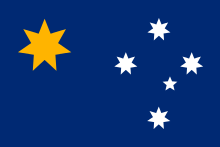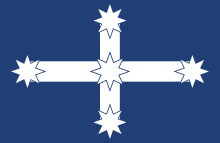User:Matty2002

The Australian flag debate is a low-key but persistent debate over whether the Australian flag should be changed in order to remove the Union Flag from the canton, often in connection with the issue of republicanism in Australia. This debate has come to a head at a number of occasions, such as the period immediately preceding the Australian Bicentenary in 1988, and also during the Prime Ministership of Paul Keating, who had publicly supported a change in the flag.
Arguments in favour of changing the flag[edit]
[[:Image:Ausflag identity.gif|thumb|A poster released by Ausflag prior to the 2000 Sydney Olympics, displaying some of the many other flags containing the Union Flag in the canton.]]

The case for changing the flag has been led by the organisation known as Ausflag. The organisation has not consistently supported one design, and is opposed to the Eureka Flag, but has sponsored a number of design competitions to develop alternative flag candidates.
Supporters of changing the flag typically argue that:
- The flag is not distinctive because it contains the national flag of another country in a position of prominence. In particular, the flag is difficult to distinguish from a variety of flags based on the British Blue Ensign, most notably the national flag of New Zealand and the state flag of Victoria. For example, the Australian Monarchist League, during their "no" campaign for the Australian republic referendum in 1999, mistakenly displayed the New Zealand flag instead of the Australian flag on one of their pamphlets.[1]
- It does not accurately connote Australia's status as an independent nation. The Union flag at the canton suggests Australia is a British colony or dependency. New Zealand, Fiji and Tuvalu are the only other independent nations in the world to feature the Union Flag on their national flags. Other Commonwealth countries whose flags originally depicted the Union Flag, such as Canada, have since changed them, without becoming republics. The flag's colours of red, white and blue are neither Australia's official national colours (green and gold) nor its traditional heraldic colours (blue and gold).
- In representing only Australia's British heritage, the flag is anachronistic, and does not reflect the change to a multicultural, pluralist society. In particular, the flag makes no mention of indigenous Australians, many of whom regard the Union Flag as a symbol of colonial oppression and dispossession.[2]
- The current flag is historically not the prime national symbol. For most of the time since Federation, it was flown alongside the British Union Flag. The number of points of the stars have varied since 1901, and the current blue version was not officially adopted as the national flag until 1954. Before then, confusion reigned between whether the red or blue version was to be preferred, with the red often winning out.
- It is spurious to claim that Australians have "fought and died under the flag", given that during most of the wars Australians have been involved in, they have usually "fought under" various British flags or the Australian Red Ensign, as well as the current Blue Ensign design.[3]. The Union Flag was used to cover the coffins of Australia's war dead.[4]
- Although the flag was designed by Australians and chosen in a public competition, it still had to be approved by the British Admiralty and King Edward VII.[5]
- There are 53 countries in the Commonwealth of Nations — only five of them, including the United Kingdom, have the Union Flag in their own flag.
Replacing the Union flag with the Commonwealth Star or the Aboriginal Flag[edit]


One suggested design is to remove the Union flag and moving the Commonwealth star that represents the States and Territories from the bottom left of the flag up into the canton. [6][7]
Another suggested design was to replace the Union Flag, in the canton (upper hoist quarter), with the Aboriginal flag. Although this was put forward as a simple evolutionary design to imply the removal of British ties and inclusion of Aboriginal ties, it has not met with widespread support and it is extremely unlikely that it will be considered as a new Australian flag design.
Reasons for this include:
- In flag design, a symbol in the canton of a flag implies subordination to the group represented by the symbol.
- Harold Thomas, the designer and copyright holder of the Aboriginal flag, objects to this use, saying, "Our flag is not a secondary thing. It stands on its own, not to be placed as an adjunct to any other thing. It shouldn't be treated that way."[8]
- Aboriginal and Torres Strait Islander people are considered equally indigenous to Australia, with each represented by their own flag; the inclusion of the Aboriginal flag but omission of the Torres Strait Islander Flag may be seen as exclusive and unfair.
- The use of black alongside the flag's dark blue is regarded as poor flag design by vexillologists.
Despite this, the flag has shown up in the science fiction movie Event Horizon. In the film, Sam Neill represents an Australian crew member, and can be seen wearing the flag on the sleeve of his suit.
Arguments in favour of keeping the flag[edit]


In response to the increasing publicity surrounding proposed new flag designs, supporters of the current Australian flag formed the Australian National Flag Association to resist attempts to change the flag.
Supporters of the current version of the national flag argue that:
- It uniquely and distinctively represents Australia and its status as an independent Commonwealth Realm. The Union Flag stands for Australia's historical origins, its membership of the Commonwealth of Nations, as well as the Westminster system of parliamentary democracy. The Commonwealth Star symbolises the six original states and Australia's territories. It features the Southern Cross which shone above the continent when the first Aboriginal people arrived.[9]
- It does not imply that Australia is subordinate to Britain. Fiji is now a republic, yet it retains the Union Flag on its national flag. The flag of Hawaii has retained the Union Flag in the canton even though Hawaii is now a state within the United States of America and was a British protectorate for only one day.
- It is a popular symbol, widely and enthusiastically used by Australians of all races and creeds. No alternative national flag has attained the same degree of affection accorded to the current flag. Sporting flag designs, such as the Boxing Kangaroo, have failed to supplant it.
- It is of historical importance, containing elements of earlier flags, such as that of the Anti-Transportation League; it is also similar to the Blue Ensign designs of all the states' flags.
- The existing flag is important for emotional reasons [citation needed]. It has been used by the Royal Australian Navy since its inception in 1911 and by other branches of the Australian Defence Force one way or another since shortly after Federation.[10][11]
- It was designed by Australians and chosen through an open public competition.[5]
The Southern Cross[edit]

Most supporters of a new flag wanted to keep the Southern Cross in any future design, with the Southern Cross featuring in almost all suggested replacement flags submitted to Ausflag.[12]
Supporters and detractors of the current flag agree that the Southern Cross represents Australia's position in the Southern Hemisphere (see Southern Cross Flag). The Southern Cross was also known to ancient Aborigines and features in a number of their traditional legends.[13] The Southern Cross was also used the first time that any part of the Australian continent was claimed as a Republic.
Progress of the debate[edit]
On 24 March 1998, the Flags Amendment Bill was adopted with all-party support in the Australian Parliament. The Bill amended the Flags Act of 1953 to ensure that the Australian national flag can only be changed by referendum of the Australian people. However, as with all legislation the amendment itself is subject to repeal or further amendment by the Parliament itself.
References[edit]
- ^ AML pamphlet during 1999 republic referendum, with the NZ flag incorrectly used instead of the Australian flag
- ^ Speech by Lois O'Donoghue, 1998.
- ^ "Australian Red Ensign - Myths and Facts". Ausflag. 2006-06-12. Retrieved 2007-12-17.
- ^ "Documenting a Democracy". National Archives of Australia: Flags Act 1953: History. Retrieved 2008-06-18.
{{cite news}}: Unknown parameter|coauthors=ignored (|author=suggested) (help) - ^ a b "History of the Australian flag: Obtaining approval from London". Flags of the World. Retrieved 2008-03-04. Cite error: The named reference "competition" was defined multiple times with different content (see the help page).
- ^ Ausflag 2000 Professional Designers Competition
- ^ This design has been used by the Republican Party of Australia since it was founded in the 1950s.
- ^ Debra Jopson (1994-09-03). "Aboriginal flag has many roles, says designer". Sydney Morning Herald.
- ^ Professor Geoffrey Blainey, Flag Day 2001 address, Brisbane.
- ^ George Odgers, "The Royal Australian Navy - An Illustrated History", p. 41
- ^ M.O.58 (1908) Attention is directed to Statutory Rule 27/08 published in M.O. 58/08. The Australian Ensign will accordingly be flown at all flag stations throughout the Commonwealth. M.O.135 (1911) It is directed that in future the Australian Flag is to be used as the saluting flag at all reviews and ceremonial parades. Source: Australian Army Military Orders
- ^ "1998 Ausflag Professional Flag Design Competition".
- ^ The story of Mululu and his four daughters
Links to alternative designs[edit]
- Ausflag
- WebRing - New Australian Flag Designs
- FlagOZ - Southern Cross and Boomerang
- Reconciliation Flag
- Seven Golden Stars
- Green and gold circle

